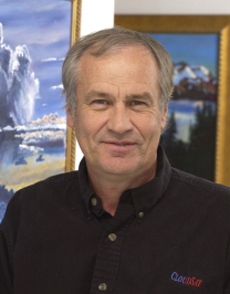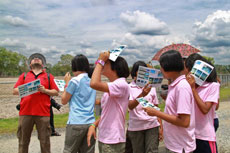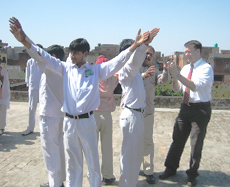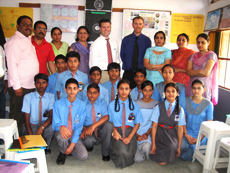Stars and STEM Stories
GLOBE CloudSat Mission Involves Students in Climate Research
CloudSat, a joint National Aeronautics and Space Administration (NASA) and Canadian Space Agency (CSA) satellite, is providing the first global survey of cloud profiles and cloud physical properties, with seasonal and geographical variations, needed to evaluate the way clouds are parameterized in global models and contributing to improved predictions of weather, climate, and the cloud-climate feedback problem.
CloudSat measures the vertical structure of clouds and precipitation from space primarily through 94 GHz radar reflectivity measurements, but also by using a combination of observations from the EOS Afternoon Constellation of satellites (A-Train). CloudSat flies in on-orbit formation with the Aqua and CALIPSO satellites, providing a unique, multi-satellite observing system particularly suited for studying the atmospheric processes of the hydrological cycle. Unfortunately, OCO did not successfully join the A-Train Constellation as planned but all other satellites in this series are successfully gathering important atmospheric data.
Since CloudSat's central mission is to study clouds and their role in governing Earth's weather and climate, CloudSat continually measures the distribution of clouds around Earth and reports how much water is contained within those clouds. This also allows the identification of cloud types, and particularly, the types of clouds that produce rain. Since its launch, scientists have incorporated CloudSat data in over one hundred scientific studies about clouds and Earth's atmosphere and worked with students to gather additional data serving to ground truth and further investigate Earth's climate system. Dr. Graeme Stephens, CloudSat Principal Investigator, stated, "For the first time, we're seeing inside the clouds."We can see tropical storms 15 kilometers deep organized on scales of thousands of kilometers across." Deputy Principal Investigator Deb Vane added, "Freshwater on this planet is a precious commodity and it comes from clouds. If we can better understand the process that controls precipitation in clouds, we can better understand the challenges we might face in the future."
An extremely successful collaboration of GLOBE schools has been formed through the CloudSat Education Network (CEN), consisting of over 80 GLOBE schools spanning across 5 GLOBE regions. Currently, schools from 11 countries participate in the CEN: Canada and the United States (North America Region) along with Australia, India, New Zealand and Thailand (Asia-Pacific Region), Croatia, Estonia and Germany (Europe-Eurasia Region), Cameroon (Africa Region) and the Dominican Republic (Latin America-Caribbean Region).
Every 16 days, after 233 revolutions of the Earth, CloudSat crosses the equator at exactly the same geographic longitude as it did before. Students gather atmospheric data on the same day that CloudSat passes over their school and compare their findings with the satellite data recorded on the same day! Students communicate with scientists, conduct research with satellite data, learn about other cultures, and make genuine scientific contributions to the mission. Currently, 54 schools are reporting GLOBE cloud data on days when the CloudSat Satellite passes overhead. Dr. Matt Rogers, Atmospheric Scientist at Colorado State University, noted: "We've found that student observations of different cloud types, especially when they've taken photographs to document their observations, are really useful to help scientists analyze satellite data for accuracy and quality control purposes."
Highlights from the CEN include:
Africa
The African country of Cameroon has been part of the CEN network since 2006 when GLOBE Teacher Ms. Grace Ngouffo at the Industrial and Commerical Technical School (LTIC) in Bafoussam began assisting students in the use of cloud charts, thermometers, cameras, and concave mirrors to collect data that would then be compared to observations recorded by the CloudSat satellite. Since that time, LTIC has been joined by another Cameroon school, Government Bilingual High School (NDOP), under the direction of Mr. George Afong, in providing some of the most numerous and accurate data of all participating CEN schools. As a result, two NASA Scientists, Dr. Peter Falcon, and Dr. Todd Ellis, paid a visit to Cameroon in June 2008 to meet with students in their classroom. To their great surprise, they discovered one single laptop being used by over 20 students to report data. Following the visit, the scientists wrote a grant to the NASA Jet Propulsion Laboratory for the purchase of additional computers and in 2009, 31 computers were provided to continue facilitation of the excellent work provided by students at the two schools. According to Ms. Ngouffo, "We will continue to work ardently in this program in hopes that one day our students will work for NASA, and become the scientific researchers of tomorrow."
Asia and the Pacific
Under the guidance of GLOBE Thailand Country Coordinator and IPST President, Dr. Pornpun Waitayangkul, the Thailand team has undertaken many CloudSat activities in the past year. Dr. Matt Rogers corresponds closely with team members Dr. Krisanadej Jareonsutasinee, Dr. Mullica Jaroensutasinee and Wittaya Pheera from Walailak University to sustain awareness of CloudSat activities in Thailand. On 6-7 January 2010, the team hosted a CloudSat Workshop, attended by 20 teachers and 20 students from 10 schools. Each class that participated in CloudSat research investigations was represented by a couple of students who presented their projects at the conference. This was a great start to a collaboration that will allow the next generation of scientists to share methods and compare data and observations about their local environments. The Climate Change Education and Earth System Science (CES2) Conference was also held in Phuket, Thailand on 8-10 January 2010. Thirty Thai GLOBE teachers and students presented a total of 10 research projects on how weather parameters, cloud cover percentages, and CloudSat images are related to local organisms and environments. The CloudSat workshop and the CES2 Conference were both funded by the GLOBE Thailand, IPST and strongly supported by Dr. Pornpun Waitayangkul.
Eight Schools in Punjab, India, were among a group of exemplary private and government schools performing well in the areas of math, science, and technology that were selected to participate in the CEN. Students were trained in the GLOBE cloud protocols for this project, teaching them to identify cloud type and variability. Students use these skills to record cloud observations every 16 days as the satellite passes over their schools and compile them into research reports. Students within the CEN network have the opportunity to attend a research conference in their home countries as part of CloudSat's educational mission. CloudSat schools recently received the honors of 1st, 2nd, and 3rd places at the student competition in New Delhi. The first place winner used CloudSat research to create a poster on cloud formation.
High school students in Punjab were also recently inspired to express their perceptions of clouds through artwork by Dr. Graeme Stephens, CloudSat principal investigator. In a culmination of Stephens' unique skills as a renowned professor, atmospheric scientist, and talented artist, he crafted a series of oil paintings depicting cloud formations that were displayed at the satellite launch of CloudSat and CALIPSO, and are currently displayed on the walls at Colorado State University's Department of Atmospheric Science. Students painted images of cloud formations on canvas, which they displayed at their school in Jalandhar, portraying to their peers how Cultural Arts can be utilized to expand understanding of Science.
In 2008, students at Westall Secondary College in Melbourne, Australia learned the importance of satellites by creating handheld satellite models. Roland Gesthuizen and his 7th through 12th-grade Research Science students created models containing all the essential parts of a satellite, including instruments, solar arrays, antennae, and more, out of common household materials. Students then placed their models on a starry background to get an idea of what CloudSat looks like in orbit against the night sky.
Europe/Eurasia
CloudSat school OS Konjscina in Croatia maintains a GLOBE blog, which acts as a virtual poster, to inform the GLOBE and CEN community of their activities throughout the year. Highlights from the blog are then also presented at the domestic annual students' conference in May.
At thirteen years old, Kristin Kikerpill from Paide, Estonia wrote a letter about her class's involvement in GLOBE and CloudSat. She and three other classmates became CloudSat Observers in the fall of 2006 and are still reporting data today. In the letter, she expresses the value of knowledge she has obtained by being a part of the CEN network, mentioning "I am quite proud to be a part of the CloudSat project. When I was in grades 5 and 6, I already knew a lot of the Latin cloud terms." The classmates began by taking pictures of clouds, obtaining help from older students to record observations. The following year they were introduced to Hydrology Protocols and how they are related to clouds. Now the students are using the things they have learned to teach younger students how to make observations as real scientists. Learning these skills are extremely beneficial to the students' futures, as Kikerpill notes, "The project improves the sense of responsibility because the measurements must be taken every day in the right place and time."
Schools from Estonia, Croatia, and Germany are currently part of the CEN network. Planning is in progress for a CloudSat Europe Conference 25-30 September 2010 in Paderborn, Germany. Students will design research posters and express evidence of climate change through the artistic depiction of clouds. Students in Paderborn are currently working on a blog project that entails cloud observations as well as the discussion of art.
Latin America and the Caribbean
Students at Notre Dame Private School in Santo Domingo, Dominican Republic, utilized CloudSat resources to develop a special routine for cloud observations. The students perform GLOBE Cloud Protocols each day during the flag ceremony. They refer to the clouds using their scientific names and predict rainy or sunny days. In year-end surveys, parents reported they were greatly impressed by the skills the students had acquired. In June, a cloud poster prepared by Notre Dame's fifth-grade students was one of five chosen around the world to be presented in an exhibit at NASA's Jet Propulsion Laboratory (JPL) in Pasadena, California. Students created posters to discover which cloud type is the most frequent in Santo Domingo.
This year at Notre Dame's Earth Day celebration on April 22nd, a Science fair was held to commemorate the 15th year of the GLOBE Program. A presentation on CloudSat captivated the interest of the public audience, including the Cultural Attaché of the American Embassy, Mr. Robert Busse. The American Embassy recently presented a scholarship for a scientific summer camp to one of the students that presented the poster. The Council of International Schools also chose an eigth-grade student as the recipient of the "International Student Award", for her contributions to the international community. María Lorraine de Ruiz-Alma, Headmistress at Notre Dame School, tells how GLOBE's CloudSat project "changes lives and broadens the horizons of our students. Now they observe the clouds with scientific minds to record their attributes and make predictions about the weather."
North America
In 2008, while attending a conference in San Francisco, California, Dr. Falcon and Dr. Ellis paid a visit to another very active CEN school, Wagner Ranch Elementary in Orinda, California. Students asked questions about clouds and CloudSat, and even learned how to replicate a cloud in a plastic bottle. The visit motivated students to keep up with cloud observations and continue to report data that is necessary for the overarching vision of the CEN partnership.
As a new GLOBE U.S. Partner in the state of New York, Dr. Todd Ellis continues to involve students with CloudSat. Ellis's research focuses on the importance of observing rainfall and understanding the roles clouds and rain play in regulating climate. He teaches his students to generate questions such as "What makes clouds appear the way they do?" Last summer, Ellis conducted a CEN training in Costa Rica where he spoke about how to leverage the different types of clouds seen in the cloud forest versus the rainforest and the coastal regions, and how GLOBE observations can help students to explore the differences between those varied climates. Ellis is working rapidly to add New York schools to the CEN network In the near future. Equally high on his list of priorities is to utilize the many creeks and river valley plains in Central New York by studying and incorporating hydrology studies into the current CloudSat research being conducted. Ellis states, "I am excited to be offering my first training as a U.S. GLOBE Partner in August and look forward to assisting teachers to use their data to ask and answer scientific questions."
Dr. Graeme Stephens, CloudSat Principal Investigator will be one of the primary keynote speakers for the 2010 Annual Partner Meeting and Professional Development Workshop in Calgary, Alberta, Canada on Thursday, 29 July – Tuesday 3 August 2010. Co-hosted by the GLOBE Program Office, North American Canadian Partners and CloudSat, this year's meeting is built around the theme "Exploring Climate through GLOBE Student Research." (See GLOBE Canada page)
If you are not able to attend the 14th Annual Meeting and Professional Development Workshop in Calgary please check the GLOBE website for event updates and links to the presentations!
Read more about how Art and Science are combined in GLOBE Research Projects:
For more information, see the CloudSat website and access their newsletter and additional documents about all mission activities including their education and outreach efforts underway in collaboration with GLOBE.
28 July 2010









